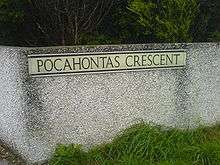Indian Queens
| Indian Queens | |
| Cornish: Krows Karworgi | |
 Indian Queens |
|
| Population | 500-600 |
|---|---|
| OS grid reference | SW917588 |
| Civil parish | St Enoder |
| Unitary authority | Cornwall |
| Ceremonial county | Cornwall |
| Region | South West |
| Country | England |
| Sovereign state | United Kingdom |
| Post town | ST. COLUMB |
| Postcode district | TR9 |
| Dialling code | 01726 |
| Police | Devon and Cornwall |
| Fire | Cornwall |
| Ambulance | South Western |
| EU Parliament | South West England |
| UK Parliament | North Cornwall |
Coordinates: 50°23′33″N 4°55′54″W / 50.3924°N 4.9317°W


Indian Queens (Cornish: Krows Karworgi) is a village in Cornwall, England, United Kingdom. The village is situated west of Goss Moor and north of Fraddon approximately ten miles (16 km) west-southwest of Bodmin.[1]
The A30 trunk road ran through the village until the construction of a bypass in the 1990s.
The village is the site of a Victorian era preaching pit constructed out of a disused quarry: the pit comprises large stepped rings and a preaching area the size and shape of half a bandstand.
Who was the Indian Queen?
A number of stories try to explain who the Indian Queen was. Each version agrees that the name comes from the name of a coach/post house or inn. The name cannot be traced earlier than the 19th century. The inn was built on a plot of land known as White Splat in the late 18th century. The Indian Queen Inn stood beside the road leading from Goss Moor to Fraddon, just below the top of the hill. The pub had a small porch and displayed as a sign the portrait of an Indian queen. An inscription on the porch told the story of a Portuguese princess who landed at Falmouth in packet days, and slept one night at this inn on her way to London. Her swarthy appearance gave onlookers the impression that she was an Indian.
It has also been suggested that the royal lady was Pocahontas (1595–1617), an American Indian who was the younger daughter of Powhatan, chief of the Indian tribes who lived along the Virginia coast. There is very little evidence to support this story; nevertheless, it is still commonly given as the origin of the name. Pocahontas's name has been given to a modern street in Indian Queens known as Pocahontas Crescent.
Up to April 1780, the inn had the name "The Queen's Head". Sometime thereafter, and definitely by 1787, it had become "The Indian Queen". It seems that the name became "The Indian Queens" around the end of the 18th century. The signboard displayed an American Indian on one side and Victoria as Queen of India on the other. (Queen Victoria reigned 1837–1901; from 1877 she was Empress of India.[2]) The pub was demolished in the 1960s and its old signboard resides in the Truro Museum. In 2009 the old stone lintel from the pub re-appeared on a house in Indian Queens not far from the site of the original pub. It bears the inscription
"THE INDIAN QUEEN
LICENSED BREWER AND RETAILER OF BEER, CYDER, WINE, AND TOBACCO.
LICENSED to the POST HORSES"
Musical associations
On his 2001 CD The Convincer, singer Nick Lowe wrote and sang a song called "Indian Queens", about a drifter who yearns to return there after a lifetime of travelling.
References
- ↑ Ordnance Survey: Landranger map sheet 200 Newquay & Bodmin ISBN 978-0-319-22938-5
- ↑ http://www.bbc.co.uk/radio4/history/sceptred_isle/page/163.shtml?question=163
- Noall, Cyril (1966) A History of Cornish Mail- and Stage-Coaches. Truro: D. Bradford Barton ISBN 0-85153-056-7
- Douch, H. L. (1966) Old Cornish Inns and their place in the social history of the County. Truro: D. Bradford Barton
- Vigurs, C. C. (article in) Devon and Cornwall Notes and Queries; No. 416
External links
Indian Queens Brass band www.indianqueensband.co.uk
![]() Media related to Indian Queens at Wikimedia Commons
Media related to Indian Queens at Wikimedia Commons